W.E. & F. Newton
Newton & Co.
William Edward Newton, 1818-1879
Frederick Newton, 1824-1909
Herbert Charles Newton, 1859-1940
by Brian Stevenson
last updated September, 2018
In 1851, optical engineer Frederick Newton formed a partnership with his distant cousin William, a civil engineer, patent agent, and heir to an established firm of London globe-makers. Frederick brought in skills as a lens-maker, and possibly other crafts, and the partners produced microscopes, telescopes, cameras, globes, and other apparatus. The pair separated toward the end of 1856 or early 1857, with Frederick continuing the optical business as Newton & Co. The name probably indicates continued financial involvement by William and/or his family. William Edward Newton returned his energies to the family globe and patent business. Advertisements suggest that Newton & Co. largely dropped their microscope lines by the 1880s, focusing instead on magic lantern projection systems and cameras.
Microscope slides with Newton & Co. secondary labels are still seen with some frequency (Figures 1-2). Microscopes signed by W.E. & F. Newton or Newton & Co. are also fairly common (Figures 3-5). Newton’s microscopes resemble those produced by other manufactures during the 1850s - 1880s. It is likely than many of the bodies were produced by contractors, with the optics produced by Frederick and his trainees.
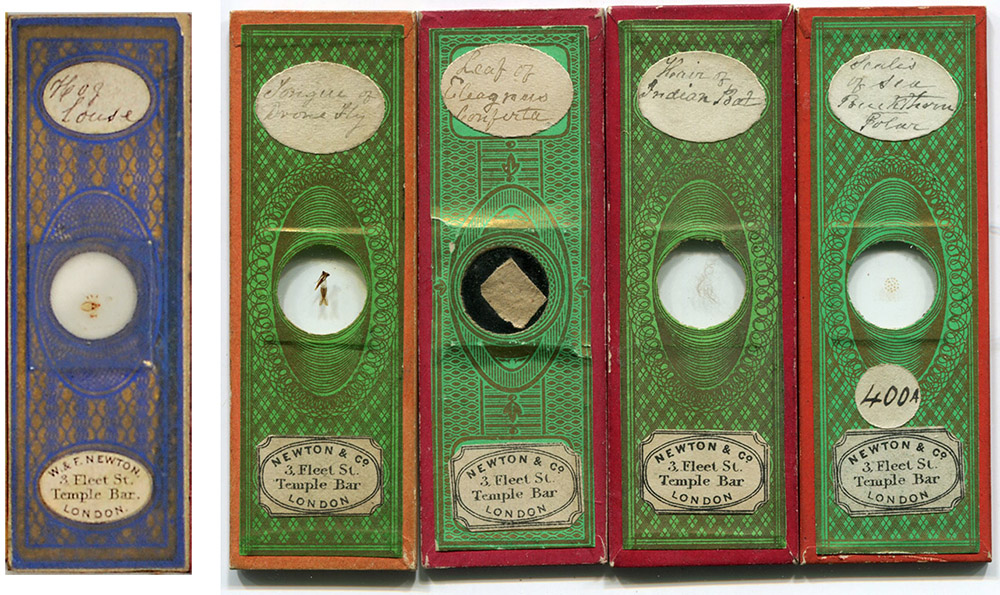
Figure 1.
Microscope slides with secondary labels from W. & F. Newton (left) and Newton & Co. (right). All of these were produced by professional slide-maker John Barnett (1816-1882), whose handwriting is readily recognized. Bracegirdle’s “Microscopical Mounts and Mounters” illustrates additional slides that were retailed by Newton & Co., one of which was prepared by John T. Norman (1807-1893).
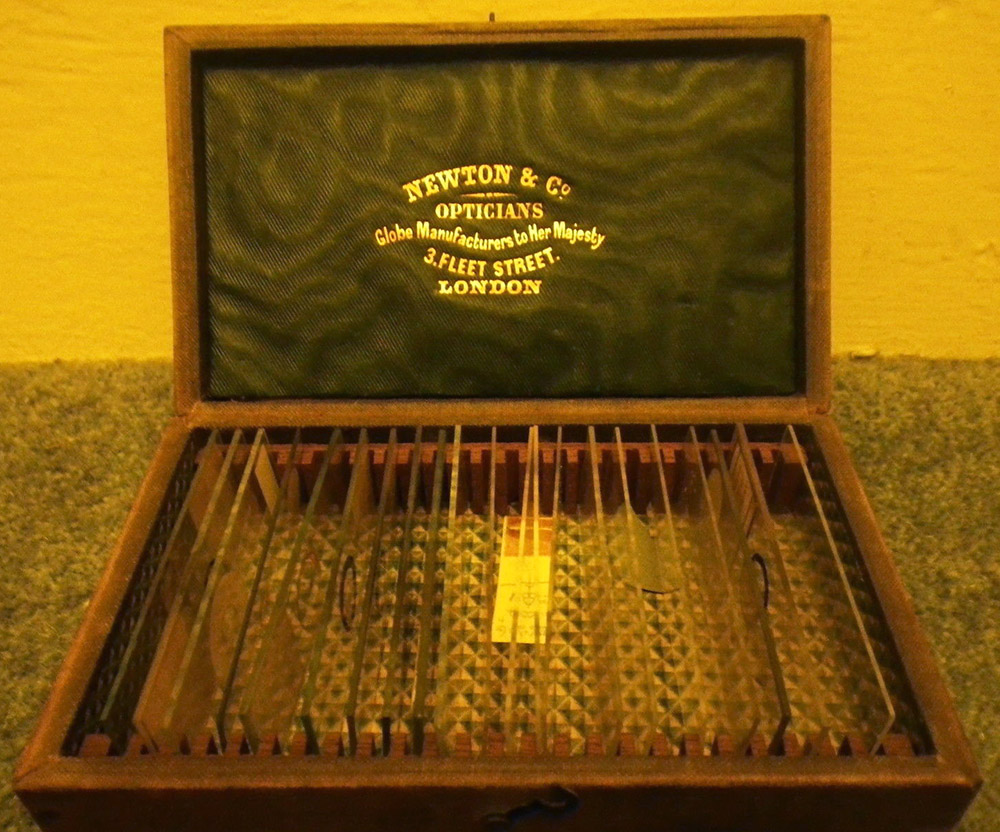
Figure 2.
A slide box from Newton & Co. Adapted for nonprofit, educational purposes from an internet auction site.
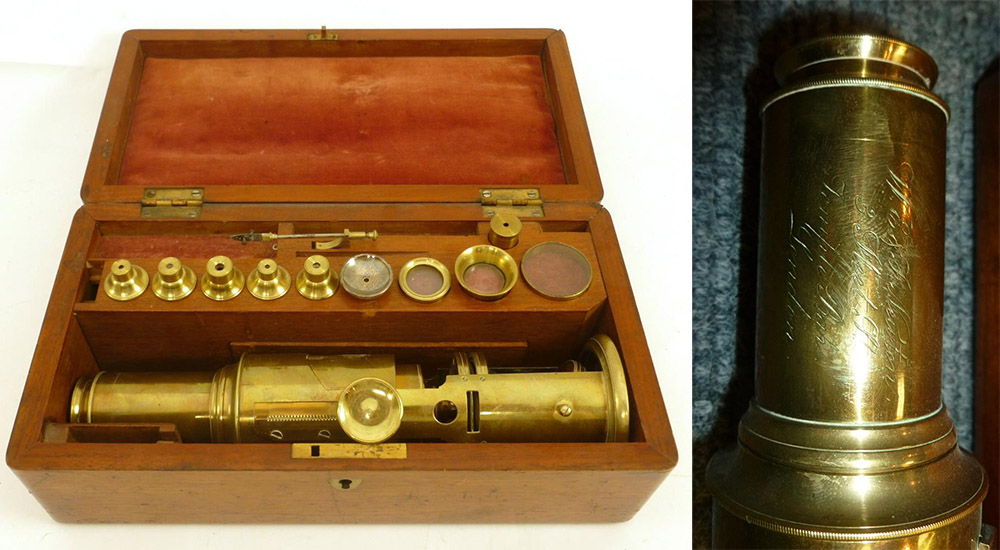
Figure 3.
A drum style microscope, signed by W.E. & F. Newton, 3 Fleet Street, Temple Bar, London. Adapted for nonprofit, educational purposes from an internet auction site.
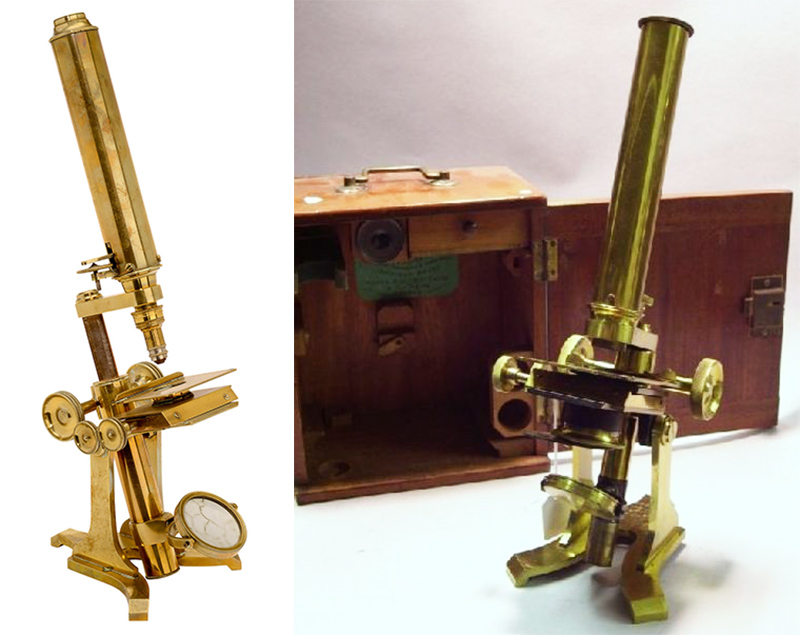
Figure 4.
Two bar-limb microscopes. The left is signed by W.E. & F. Newton, and therefore dates from between 1851 and 1857. The right is signed by Newton & Co., and dates from 1857 or later. Both images adapted for nonprofit, educational purposes from internet auction sites.

Figure 5.
The first four pages of an undated Newton & Co. catalogue, which prominently features their microscopes. The patterns suggest publication ca. 1860.
Frederick Newton was born on November 24, 1824, in Hitchen, Hertsfordshire. His father, Charles, was also born in Hitchen. While it is likely that Frederick was related to the London Newtons with whom he later partnered, they would have been fairly distant relatives. Frederick appears to have been the eldest of six children. Charles was a fairly well-to-do “linen draper”, able to provide the family with domestic servants.
Frederick moved to London as a teenager, to serve an apprenticeship with “optician” John Dennis. He was admitted to the Spectaclemakers’ Guild in October, 1850 (Figure 6). He was located at 3 Fleet Street at the time of his guild admission, and so might have already formed the business partnership with William Edward Newton.
W.E. Newton was then co-owner of Newton & Son, located at 66 Chancery Lane. The globe-making firm was established in the 1700s at 128 Chancery Lane by John Newton, evidently a cousin of Sir Isaac Newton. A relative, Nathaniel Hill, later acquired the business. Hill partnered with another John Newton (1757-1844), who became sole owner, and then passed it on to his son, William Newton (1786-1861). That William moved the business to 66 Chancery Lane. William, his son William Edward Newton, and one Miles Berry formed the business of Newton, Son and Berry in about 1832 (Figure 7). In addition to making globes, the partnership operated as patent agents, publishers, land surveyors, and civil engineers. Berry departed in 1842, and the business became Newton & Son. The 1843 Post Office Directory of London listed them as “Newton William & Son, patent agents, land surveyors & mechanical draftsmen, & globe makers, 66 Chancery lane”. Their Newton's London Journal of Arts and Sciences was a long-running repository of patent applications and awards throughout Great Britain, many of which were filed by one or more of the Newtons on behalf of clients.
Advertisements for the new business of W.E. & F. Newton appeared during early 1851. They exhibited microscopes, telescopes, opera glasses, and globes at that year’s International Exposition in London (Figure 8). Newton and Son also presented, showing the globes that had long been the family’s mainstay products. W.E. & F. Newton were located at 3 Fleet Street, while Newton & Son remained at 66 Chancery Lane. There were no clear distinctions between the two, especially because William Edward Newton was co-owner of both businesses. For example, the fourth edition of The Use of Globes, written by William Newton, was published in 1854 by W.E. & F. Newton.
W.E. & F. Newton secured an appointment to the Prince Consort, Albert, by 1851 (Figure 8). They soon became opticians and globe-makers for Queen Victoria (Figure 9). Frederick and his Newton & Co. business retained royal appointments into the twentieth century.
Frederick married Emma Charles on January 6, 1854. They had two children, Constance and Herbert Charles. His business flourished, and the Newton family always benefitted from the service of two or three domestic servants.
Frederick Newton was more than just a maker and retailer of optical instruments, he was also an inventor. He pointed out one of his photography patents in this 1856 letter, “To the Editor of the Photographic Journal. Sir, - In the last Number of the Journal there is a long description of a simple apparatus for taking pictures without the use of a dark tent, by Mr. Austen, who describes its usefulness in glowing colours, and speaks with delight of the comfort he enjoys in using it. Now Sir, if Mr. Austen looks, he will find the same apparatus described in the last 5 lines of page 41, vol. i. of the Journal; with a somewhat flattering remark from the Vice-President of the Society. I had the honour of taking out a Patent for it with other modifications, when the collodion process was in its infancy. The Patent is dated 1852, so it is scarcely yet time to reinvent it. I shall, however, be very glad to grant Mr. Austen and his friends licenses for making the same, to show them the original apparatus, and give any further information they may require; but the merit, if any, of the scheme, I should certainly like to keep in my own hands. I am, Sir, Your obedient Servant, Frederick Newton, 3 Fleet Street, December 18, 1856”.
Advertisements from W.E. & F. Newton are known from late 1856, and advertisements from Newton & Co. appeared in 1857, indicating that the corporate change occurred around New Year, 1857 (Figures 9 and 10).
Newton & Co. exhibited at the 1862 London Exhibition, displaying “Mathematical, surveying, and philosophical instruments, &c”.
Frederick’s wife, Emma, died on April 14, 1873. He remarried a few years later, to Hannah (last name not known). They had a daughter, Ethel Jane, in 1878.
William Edward Newton died on April 1, 1879, at his home in Woolsthorpe, Kent. His son, Henry, continued the Newton & Son business at 66 Chancery Lane.
The 1876 Catalogue of the Educational Division of the South Kensington Museum shows that Newton & Co. then produced two models of microscope, a “Student's Achromatic Microscope, on brass stand with trunnion joint to incline the instrument to any angle”, and a “Compound Microscope, with improved stage to take Micro-Photographs”. Both were available with accessories such as mechanical stages. They offered several different types of magic lantern, which was becoming a main product of Newton & Co.
The 1886 advertisement shown in Figure 11 illustrates that trend away from microscopes, offering only a student’s compound microscope and botanical magnifying lenses. Table-top microscopes were not mentioned in the 1893 advertisement shown in Figure 12.
Hannah, Frederick’s second wife, died during the mid-1890s. The 1901 census lists Frederick as a “retired Scientific Instrument Maker, living with daughter Ethel, a 38 year-old “companion” named Julia Booth, a cook, a parlour maid, and a housemaid. Frederick died on October 3, 1909.
Frederick's only son, Herbert Charles Newton, continued the Newton & Co. business in partnership with R.S. Wright. The business moved to 37 King Street, Covent Garden, in 1912. The partnership dissolved in 1920, with each man continuing a business named "Newton & Co.". H.C. Newton continued at 37 King Street until 1926, when he moved to 43 Museum Street (Figure 14). H.C. Newton's shop closed in 1937, a few years before his death. R.S. Wright's version of "Newton & Co." was located at 71 or 72 Wigmore Street until 1953.
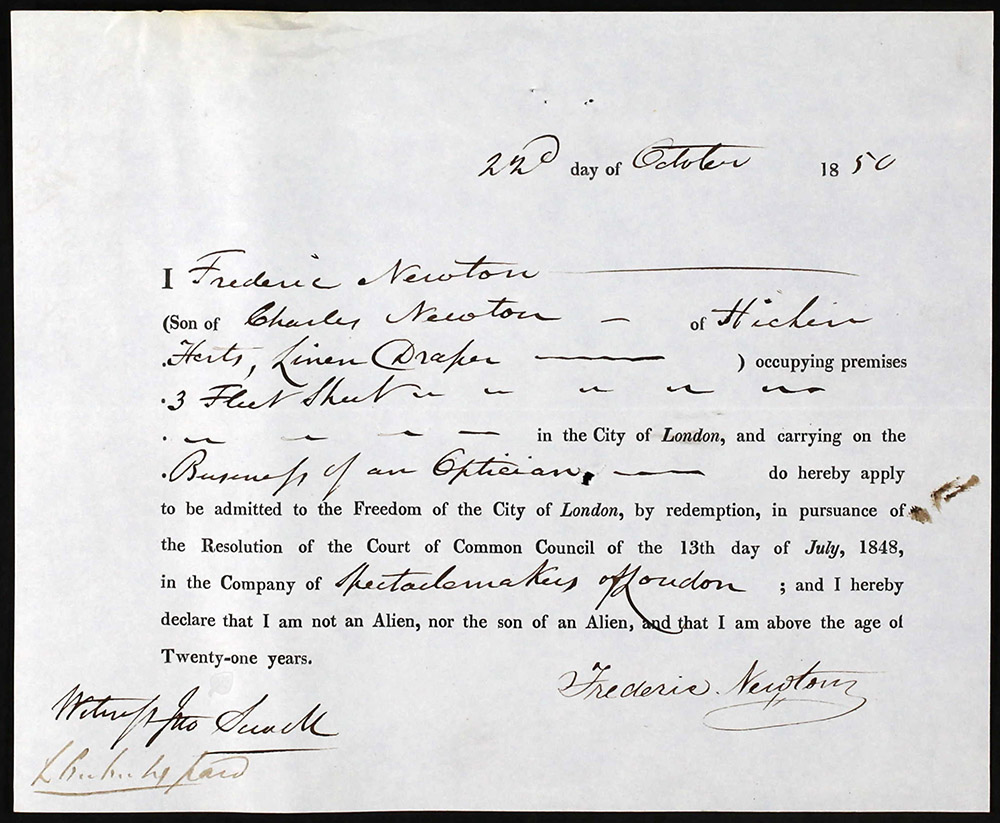
Figure 6.
Part of Frederick Newton’s October 22, 1850, paperwork under which he became a member of the London Guild of Spectaclemakers.
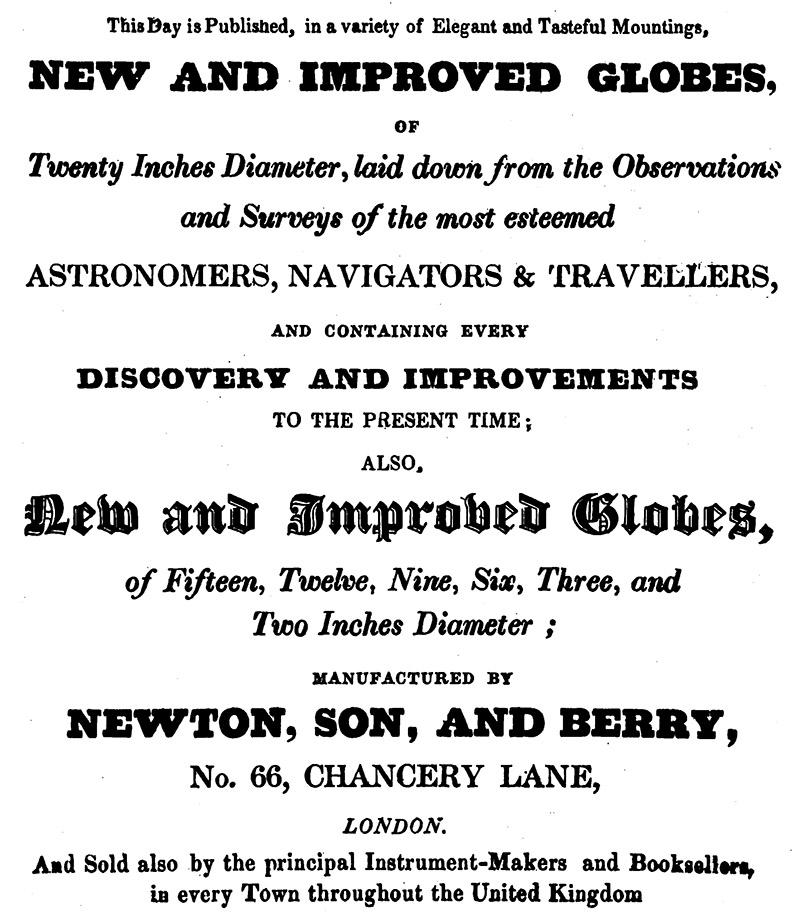
Figure 7.
An 1832 advertisement from Newton, Son, and Berry, of 66 Chancery Lane. Berry left the partnership in April, 1842, leaving William Newton and William E. Newton to form Newton & Son.
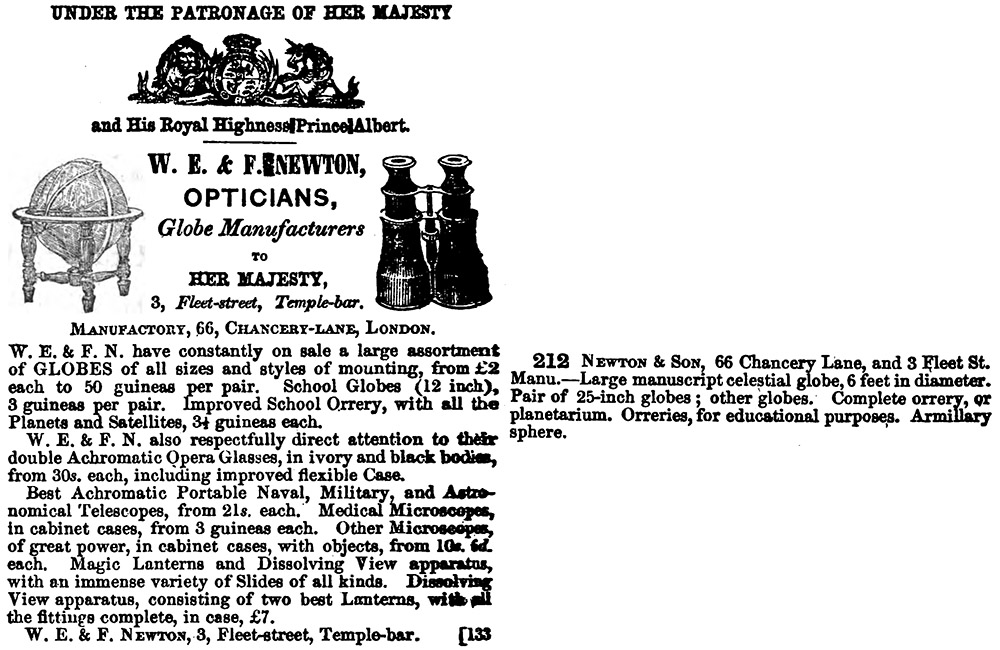
Figure 8.
From the Catalogue of the 1851 London International Exhibition. Both W.E. & F. Newton and Newton & Son exhibited.

Figure 9.
An 1856 advertisement by W.E. & F. Newton, from “Bradshaw's Itinerary of Great Britain”.
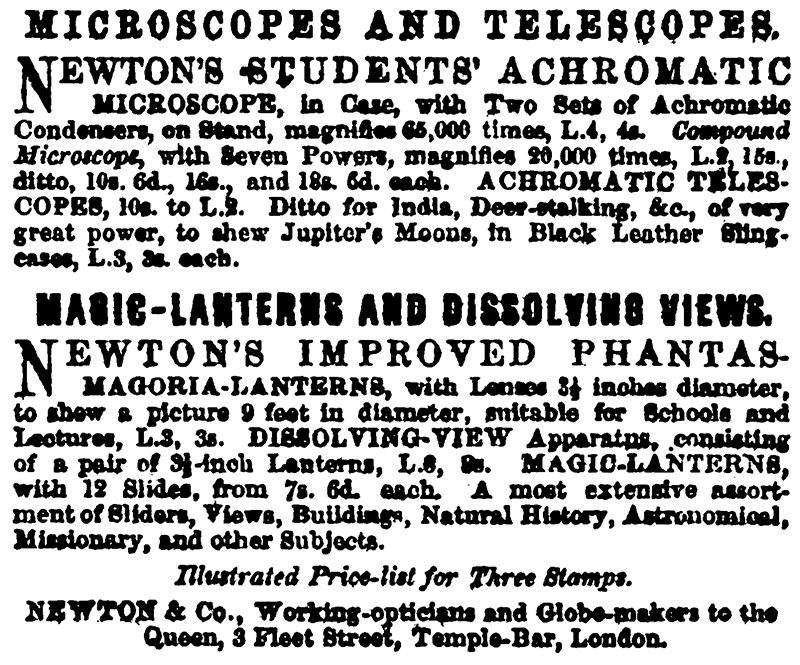
Figure 10.
An 1857 advertisement for Newton & Co., from “Chamber's Journal of Popular Literature, Science and Arts”.
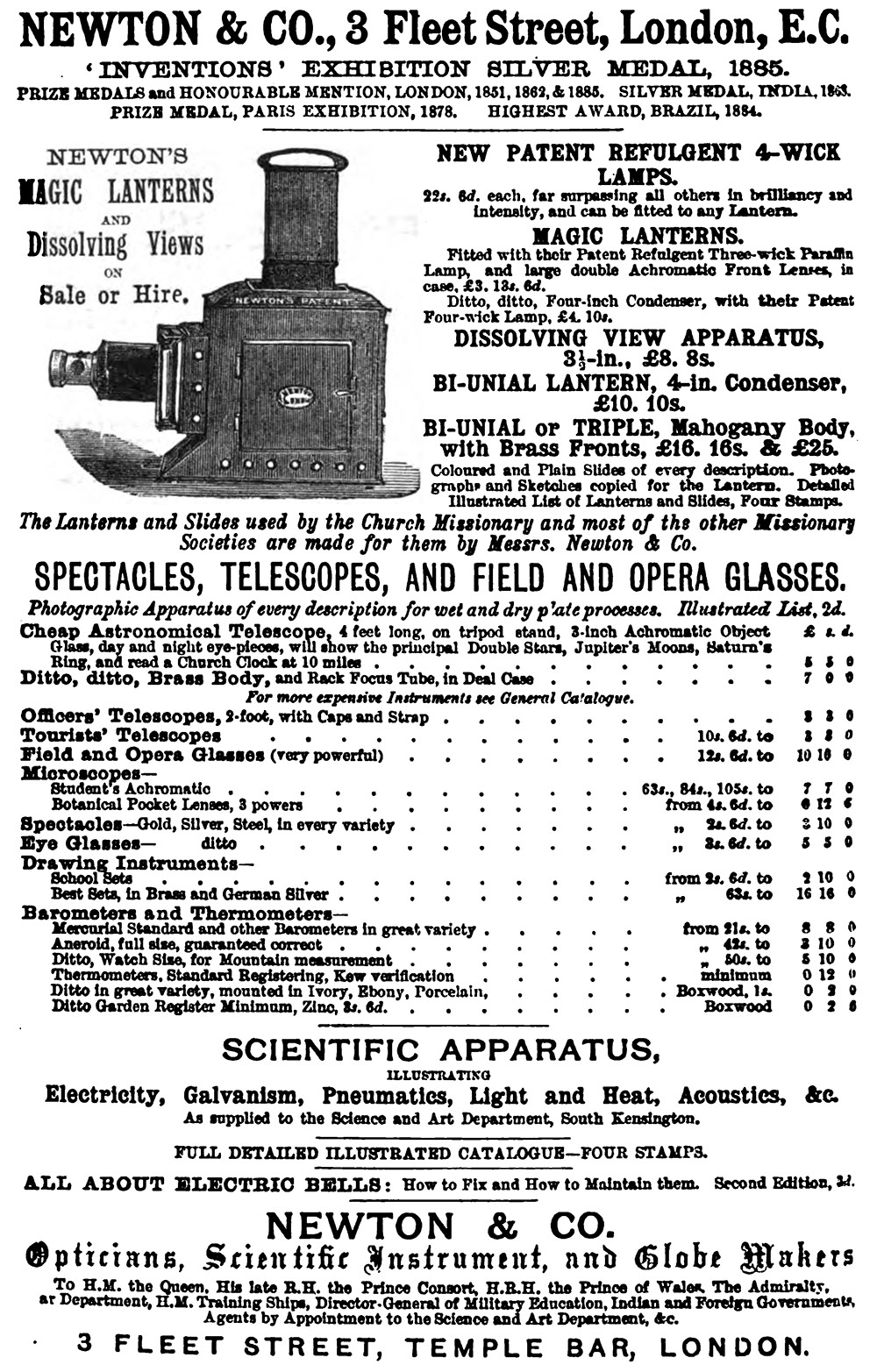
Figure 11.
An 1886 advertisement, from “The Official Year-book of the Church of England”. Note that only one type of microscope was being offered at that time.
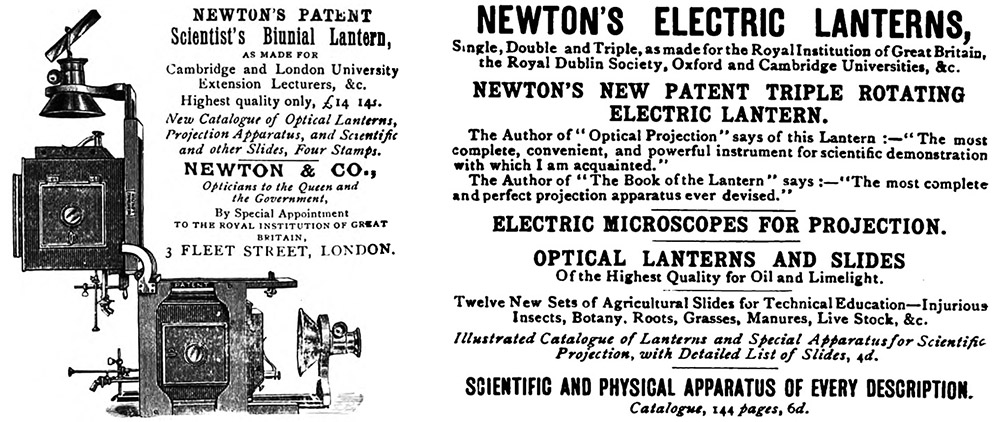
Figure 12.
1892 and 1893 “Nature” advertisements, emphasizing projection lanterns.
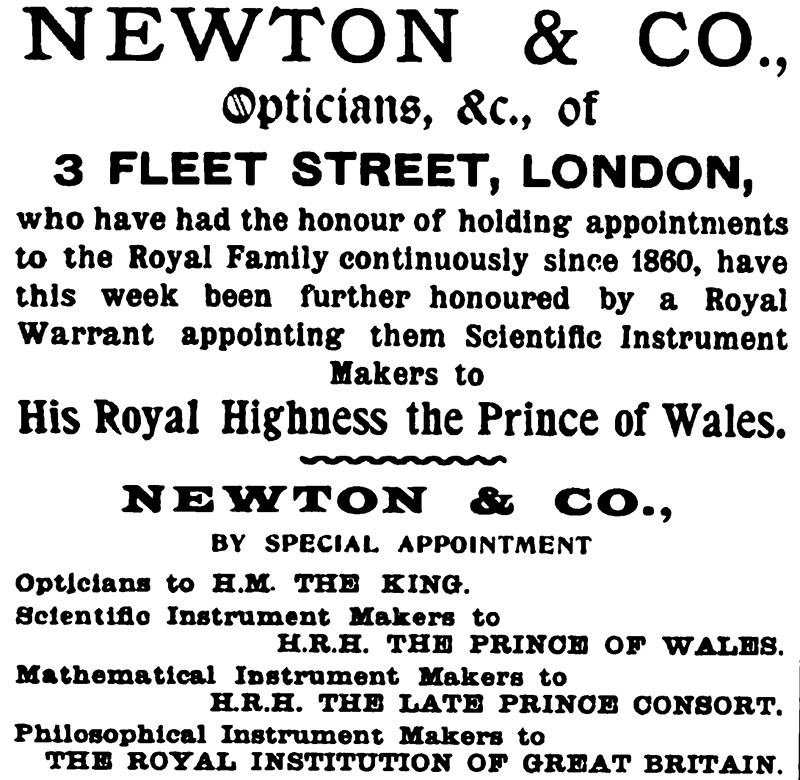
Figure 13.
A 1904 advertisement, from “Nature”.
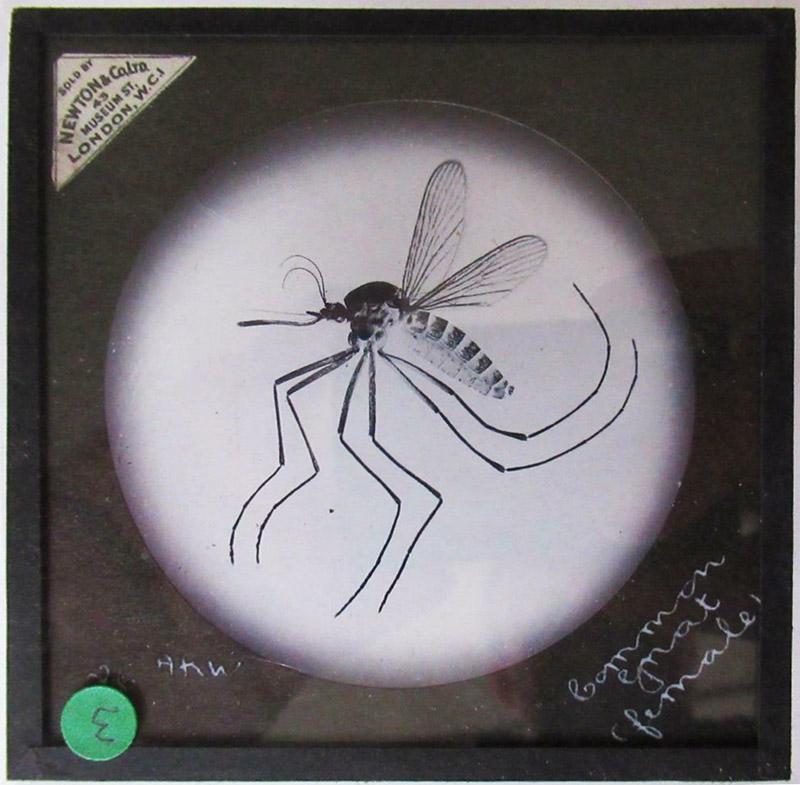
Figure 14.
A magic lantern slide from Newton & Co. The address of 43 Museum Street inidcates that it was sold by Herbert C. Newton's shop between 1926 and 1937. Adapted for nonprofit, educational purposes from an internet auction site.
Resources
Bracegirdle, Brian (1998) Microscopical Mounts and Mounters, Quekett Microscopical Club, London, pages 70 and 158, Plate 27-B and 27-C
Bradshaw's Itinerary of Great Britain (1856) Advertisement from W.E. & F. Newton, Bradshaw and Blacklock, Manchester, page 136
Catalogue of the Educational Division of the South Kensington Museum (1876) pages 560-561
Chamber's Journal of Popular Literature, Science and Arts (1857) Advertisement from Newton & Co., Vol. 7
England census and other records, accessed through ancestry.com
Freedom of the City of London papers of Frederick Newton (1850) accessed through ancestry.com
Knowledge (1912) Vol. 35, page 308
A List of All Patents for Inventions Granted in England During the Year 1844 (1845) Newton & Son, London
The Lancet (1856) “Microscope and Philosophical Instrument Makers … Newton, Wm. Ed., and Fred., 3 Fleet-street”, September 20, page 343
The London Gazette (1842) “Notice is hereby given, that the Partnership carried on between William Newton and Miles Berry, under the firm of Newton, Son, and Berry, as Patent Agents, Land Surveyors, Mechanical Draftsmen, and Civil Engineers, at No. 66, Chancery-lane, Holborn, in the county of Middlesex, and also at Town-hall-buildings, Manchester, in the county of Lancaster, was this day dissolved by mutual consent; and that all debts due to the said partnership will be received, and all debts due from the said partnership will be paid, by the said William Newton; and the business will for the future be carried on under the firm of Newton and Son. - Dated the 16th day of April 1842. - William Newton, Miles Berry”. page 1086
The London Journal of Arts and Sciences (1832) Advertisement from Newton, Son, and Berry, Vol. 8
LUCERNA – the Magic Lantern Web Resource (accessed December, 2021) Newton & Co., lantern and slide manufacturer and supplier, http://lucerna.exeter.ac.uk/organisation/index.php?language=EN&id=1000428
Nature (1893) Advertisement from Newton & Co., Vol. 47, January 11, page xci
Nature (1904) Advertisement from Newton & Co., Vol. 70, May 2, cover page
Newton, Frederick (1856) Invention of Austen’s camera disputed, Photographic Journal, page 189
Newton, William (1854) The Use of Globes, W.E. & F. Newton, London
Newton's London Journal of Arts and Sciences (1852) page 384, Newton & Son, London
Official Catalogue of the Great Exhibition of the Works of Industry of All Nations (1851) pages 67 and advertiser page 8
Official Catalogue of the Industrial Department (1862) “2940 Newton & Co. 3, Fleet-st. London. - Mathematical, surveying, and philosophical instruments, &c.”, page 48
The Official Year-book of the Church of England (1886) Advertisement from Newton & Co., page xviii
The Post Office London Directory (1843) “Newton William & Son, patent agents, land surveyors & mechanical draftsmen, & globe makers, 66 Chancery lane”, page 307
Probate of the will of Frederick Newton (1909) “Newton Frederick of Hillside Lawn 66 Hornsey-lane Middlesex died 3 October 1909 Probate London 16 October to Herbert Charles Newton optician the Reverend Ernest Newton Coulthard clerk and Joseph John Elmer engineer. Effects £39986 16s 4d”, accessed through ancestry.com
Probate of the will of Herbert Charles Newton (1940) “Newton Herbert Charles of 16 Cumberland Mansions Marylebone London died 19 February 1940 Probate London 3 May to Eric Kenyon Andrews Boyce schoolmaster and Geoffrey Arthur Holme Bower and Christopher Walter Bower solicitors. Effects £57056 8s 7d”, accessed through ancestry.com
Probate of the will of William Newton (1861) “The Will of William Newton formerly of 66 Chancery-lane in the County of Middlesex but late of Clarence House Herne Bay in the County of Kent Gentleman deceased who died 10 July 1861 at Clarence House aforesaid was proved at the Principal Registry by the oaths of William Edward Newton of 66 Chancery-lane aforesaid Engineer the Son and Isaac Vincent of 32 Portland-place Lower-road Islington in the said County of Middlesex Esquire the Executors. Effects under £6,000”, accessed through ancestry.com
Probate of the will of William Edward Newton (1879) “The Will of William Edward Newton late of 66 Chancery-lane in the County of Middlesex and of Woolsthorpe the Avenue Gipsy Hill in the County of Surrey Civil Engineer and Patent Agent who died 1 April 1879 at Woolsthorpe was proved at the Principal Registry by Mary Ann Newton of Woolsthorpe Widow the Relict and Henry Edward Newton of 66 Chancery-lane Gentleman the Son the Executors. Personal Estate under £10,000”, accessed through ancestry.com
Wakefield's Merchant and Tradesman's General Directory for London (1794) “Newton, John, Globe maker, 128, Chancery-lane”, page 224













